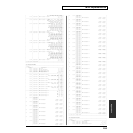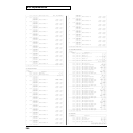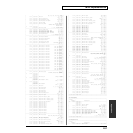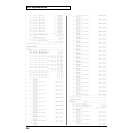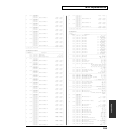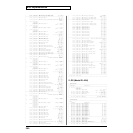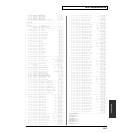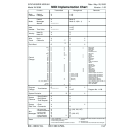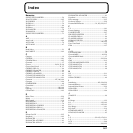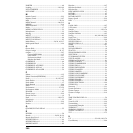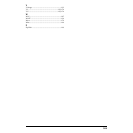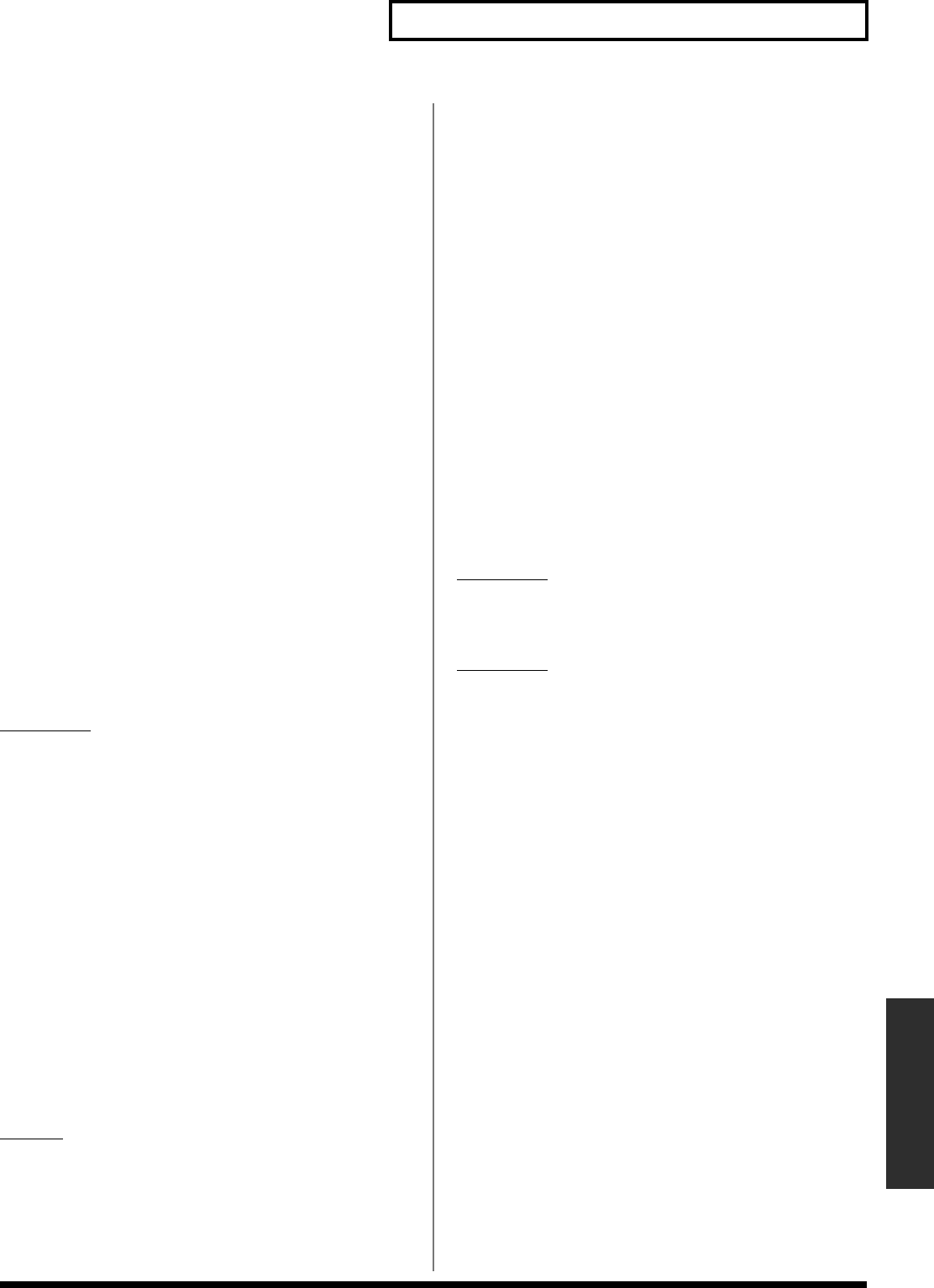
303
MIDI Implementation
Appendices
during the song and then rewound or fast-forwarded, the sequencer may not be able to
transmit the correct status, and the sound generator will then misinterpret the data. Take
care to give each event its own status.
It is also necessary that the RPN or NRPN parameter number setting and the value setting
be done in the proper order. On some sequencers, events occurring in the same (or
consecutive) clock may be transmitted in an order different than the order in which they
were received. For this reason it is a good idea to slightly skew the time of each event (about
1 tick for TPQN = 96, and about 5 ticks for TPQN = 480).
* TPQN: Ticks Per Quarter Note
●
Example of an Exclusive message and calculating a
checksum
Roland Exclusive messages (RQ1, DT1) are transmitted with a checksum at the end (before
F7) to make sure that the message was correctly received. The value of the checksum is
determined by the address and data (or size) of the transmitted Exclusive message.
❍
How to calculate the checksum (hexadecimal numbers are indicated by
"H")
The checksum is a value derived by adding the address, size, and checksum itself and
inverting the lower 7 bits.
Here's an example of how the checksum is calculated. We will assume that in the Exclusive
message we are transmitting, the address is aa bb cc ddH and the data or size is ee ffH.
aa + bb + cc + dd + ee + ff = sum
sum ÷ 128 = quotient ... remainder
128 - remainder = checksum
<Example 1> Setting CHORUS TYPE of PERFORMANCE COMMON to DELAY (DT1).
According to the "Parameter Address Map (p. 290)", the start address of Temporary
Performance is 10 00 00 00H, the offset address of CHORUS at PERFORMANCE COMMON
is 04 00H, and the address of CHORUS TYPE is 00 00H. Therefore the address of CHORUS
TYPE of PERFORMANCE COMMON is;
10 00 00 00H
04 00H
+) 00 00H
10 00 04 00H
DELAY has the value of 02H.
So the system exclusive message should be sent is;
F0 41 10 00 10 12 10 00 04 00 02 ?? F7
(1) (2) (3) (4) (5) address data checksum (6)
(1) Exclusive Status, (2) ID (Roland), (3) Device ID (17),
(4) Model ID (XV-5080), (5) Command ID (DT1), (6) End of Exclusive
Then calculate the checksum.
10H + 00H + 04H + 00H + 02H = 16 + 0 + 4 + 0 + 2 = 22 (sum)
22 (sum) ÷ 128 = 0 (quotient) ... 22 (remainder)
checksum = 128 - 22 (remainder) = 106 = 6AH
This means that F0 41 10 00 10 12 10 00 04 00 02 6A F7 is the message should be sent.
<Example 2> Getting the data (RQ1) of Performance Part 3 in USER:03.
According to the "Parameter Address Map (p. 290)", the start address of USER:03 is 20 02 00
00H, and the offset address of Performance Part 3 is 00 22 00H.
Therefore the start address of Performance Part 3 in USER:03 is;
20 02 00 00H
+) 00 22 00H
20 02 22 00H
As the size of Performance Part is 00 00 00 21H, the system exclusive message should be
sent is;
F0 41 10 00 10 11 20 02 22 00 00 00 00 21 ?? F7
(1) (2) (3) (4) (5) address data checksum (6)
(1) Exclusive Status, (2) ID (Roland), (3) Device ID (17),
(4) Model ID (XV-5080), (5) Command ID(RQ1), (6) End of Exclusive
Then calculate the checksum.
20H + 02H + 22H + 00H + 00H + 00H + 00H + 21H = 32 + 2 + 34 + 0 + 0 + 0 + 0 + 33 = 101
(sum)
101 (sum) ÷ 128 = 0 (quotient) ... 101 (remainder)
checksum = 128 - 101 (remainder) = 27 = 1BH
This means that F0 41 10 00 10 11 20 02 22 00 00 00 00 21 1B F7 is the message should be sent.
<Example 3> Getting Temporary Performance data (RQ1);
cf.) This operation is the same as Data Transfer function in Utility mode with "PERFORM"
(Type parameter) and "TEMP: -PATCH" (Source parameter) options.
According to the "Parameter Address Map (p. 290)", the start address of Temporary
Performance is assinged as following:
10 00 00 00H Temporary Performance Common
:
10 00 20 00H Temporary Performance Part 1
:
10 00 3F 00H Temporary Performance Part 32
As the data size of Performance Part is 00 00 00 21H, summation of the size and the start
address of Part 32 at Temporay Performance will be;
10 00 3F 00H
+) 00 00 00 21H
10 00 3F 21H
And the size that have to be got should be;
10 00 3F 21H
-) 10 00 00 00H
00 00 3F 21H
Therefore the system exclusive message should be sent is;
F0 41 10 00 10 11 10 00 00 00 00 00 3F 21 ?? F7
(1) (2) (3) (4) (5) address data checksum (6)
(1) Exclusive Status, (2) ID (Roland), (3) Device ID (17),
(4) Model ID (XV-5080), (5) Command ID (RQ1), (6) End of Exclusive
Calculating the checksum as shown in <Example 2>, we get a message of F0 41 10 00 10 11
10 00 00 00 00 00 3F 21 10 F7 to be transmitted.
<Example 4> Getting data (RQ1) at once;
Tempory Performance data,
Temporary Patch data of whole part in Performance mode,
Temporary Rhythm data of whole part in Performance mode.
cf.) This operation is the same as Data Transfer function in Utility mode with "PERFORM"
(Type parameter) and "TEMP: +PATCH" (Source parameter) options.
According to the "Parameter Address Map (p. 290)", the start address of the
above all parameters is assinged as following:
10 00 00 00H Temporary Performance
11 20 00 00H Temporary Patch (Performance Mode Part 1)
11 30 00 00H Temporary Rhythm (Performance Mode Part 1)
:
14 60 00 00H Temporary Patch (Performance Mode Part 16)
14 70 00 00H Temporary Rhythm (Performance Mode Part 16)
The offset address of Rhythm is also assigned as follows:
00 00 00H Rhythm Common
:
00 10 00H Rhythm Tone 1
:
01 3E 00H Rhythm Tone 4



